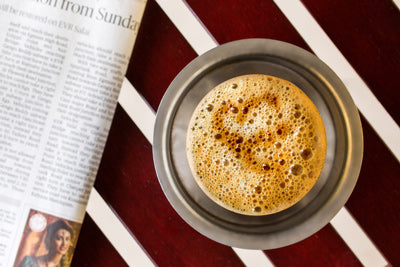It's about time an ultimate guide to Indian filter coffee was put together. So here it is. All you need to know about the Indian filter coffee. Right from its history, addition of chicory, brewing technique and preparation, how it's different from western filter coffees, this is the one and only definitive guide you'll ever need to understand this centuries old beverage! Let's dig in \m/
Plus we've made it as simple as possible for you to follow by using 'coffee jargon' as little as possible!
We'll cover the following (feel free to navigate to the section you are most interested in),
-
KAAPI - What's in a name?
-
History of Indian Filter Coffee in India
-
What is chicory and it's role in Indian Filter Coffee?
-
What to expect when a coffee is labelled Indian Filter Coffee?
-
Indian Filter Coffee at a cafe
-
Coffee Extraction ~ The 'Decoction' Brewing Technique
-
Preparation & Serving Style ~ Making Indian Filter Coffee
-
Frothing Indian Filter Coffee
-
Indian Filter Coffee vs Western Filter Coffee
KAAPI - What's in a name?
Most Indian coffee is grown in the Southern Indian states of Karnataka, Tamil Nadu, Kerala and Andhra Pradesh. While each of these states have their own distinct culture and language, the word KAAPI means coffee!
KAAPI was probably adopted as a phonetic rendering of the word coffee in South Indian languages, much like 'Kopi' in South East Asian countries or like 'Kaffee' in German.
History of Indian Filter Coffee in India
The Indian filter coffee is variously known as filter coffee, degree coffee, Mysore filter coffee or Kumbakonam coffee, and was a staple in South Indian households long before café chains serving lattes and mochas became fashionable in urban India.
After coffee was discovered and when European countries started consuming coffee, it quickly started to become a highly traded commodity by the 17th century. At the time the Indian subcontinent was colonised by the English and French troops, who commissioned coffee cultivation in the most geographically favourable parts of the country.
We know for a fact that in the early days before coffee makers were invented, coffee was extracted in the crudest possible way.
The roasted coffee beans were ground, boiled with water and consumed after allowing the coffee sediments to settle at the bottom (This is how Turkish coffee is prepared even today!). Subsequently somewhere in South India, the Indian Filter Pot was invented to refine the coffee extraction. All coffees made since then using an Indian Filter Pot came to be called Indian Filter Coffee.
What is Chicory and its role in Indian Filter Coffee?
Chicory is a plant that belongs to the dandelion family. The chicory root is what is blended into coffee.
It is rumoured that in the 17th century, when coffee was in short supply, the French and Germans started blending chicory with coffee. Some others believe that chicory was added for its medicinal properties and its use in coffee reduced the caffeine intake.
Whatever the reason, the new coffee turned out to be so flavoursome and popular that the French continued the chicory blend even after coffee became easily available.
The French colonial provinces in India at the time were scattered around the South-eastern coastline, with its capital at present day Pondicherry, a Union Territory of India adjoining Tamil Nadu. One way or another it made its way into the South Indian kitchens.
Even today cafes in New Orleans still serve chicory blended coffee, keeping strong ties with its French history!
Chicory imparts a malty flavour profile and darker shade of brown to the extracted coffee.
Is there a golden coffee to chicory ratio for the best taste?
Taste is subjective. While some people prefer higher chicory content in their coffee, others prefer pure coffee. The type of coffee beans (one bean or bean blend) and its roast profile determines to an extent the amount of chicory added, to get the final flavour profile each maker is trying to achieve. This ratio or recipe is unique to every maker. Our CHAKRAM Indian filter coffee blend uses 20-25% of chicory.
What to expect when a coffee is labelled Indian Filter Coffee?
When you buy ground coffee, what is it that makes it 'Indian filter coffee'? Is it the addition of chicory?
Put simply, most coffees are named after the coffee brewing technique it is most suitable for. Which brings us to the grind size!
add. note: the brewing technique also determines the time the coffee is in contact with water, so accordingly certain coffee roast styles are more suitable for certain brewing techniques.
Roasted coffee beans ground to the size that is most suitable to the Indian Filter Pot is Indian filter coffee as a 'type of coffee blend'.
add. note: Usually finely ground coffee (espresso grind size or sometimes even finer) can be used to brew in an Indian filter pot. As a coffee maker the Indian filter pot is quite forgiving of the grind size. The finer the grind, more flavour gets extracted, but brewing time increases.
The coffee may or may not (Kumbakonam Degree Filter Kaapi) have chicory added to it. Although, generally chicory blended Indian coffee is what most people associate Indian filter coffee with.
Indian Filter Coffee at a Cafe
At a coffee shop or stall, what can you expect if you order Indian filter coffee?
Any coffee brewed using a traditional Indian filter pot can technically be called Indian Filter Coffee. You'll need to ask specifically if the blend has chicory or not.
The Indian filter coffee is also traditionally served as a milk based coffee with sugar. When we serve our blend at pop-ups we do in Melbourne, we give dairy free alternatives with sugar being optional. Although the traditional serving style (long pour frothing) makes Indian filter coffee taste better with a touch of sugar. Again subjective!
Coffee Extraction ~ Traditional 'Decoction' Brewing Technique
Prepared in a traditional Indian filter pot, the Indian filter coffee is brewed delicately by allowing hot boiling water to seep through finely ground coffee, only helped by gravity (and the pressure built by steam inside the top chamber when closed)!
The Indian filter pot is one of the simplest coffee makers in the world.
It comprises two stainless steel/brass chambers assembled one on top of the other. The top chamber has tiny perforations which acts as the fixed filter. This chamber also houses a plunger to tamp and hold down the coffee grounds.
This contraption is simple yet effective. The filter pot doesn't use any non-metal or consumable parts like rubber gaskets, making it last a lifetime.
Here is a simple brewing guide (click here to read our detailed guide if you are just starting off, there's a video too!)
Steps
-
Assemble the chambers one on top of the other.
-
Add coffee grounds to the top chamber and tamp it down gently with the inner plunger.
-
With the plunger held in its place, slowly add hot water (off the boil). Slightly wetting the grounds before pouring the entire water speeds up the brewing process.
-
Close the filter with lid and allow to stand.
-
After approximately 15-25 minutes, the coffee collects as a thick syrupy decoction in the bottom chamber.
Preparing a cup of Indian Filter Coffee
Traditional served as a milk based coffee, the importance of milk in Indian filter coffee cannot be understated.
First off, using full cream milk (if you consume dairy) will make your final cup taste way better.
Once you've brewed the coffee decoction, all you need to do is bring a saucepan of milk to boil on the stovetop. We recommend this old-fashioned way of preparing milk for making Indian filter coffee.
Why? Because scalded milk makes all the difference to taste.
Once you've got the boiled milk, add it to the decoction. There is no standardised measures here, just depending on the strength you prefer, feel free to vary the decoction to milk ratio!
Dairy alternatives - With a growing number of people intolerant to dairy and or preferring dairy-free options, we've tested out a few milk alternatives.
We love how our blend tastes with soy milk. Almond and Oat milk works quite well too!
If you would like to read the detailed article we wrote on the importance of milk and treating it right, please click here!
Why is Indian Filter Coffee frothed manually?
Frothing the Indian filter coffee is satisfying and therapeutic on so many levels.
Indian filter coffee is traditionally served piping hot mainly because it uses scalded milk. Everywhere else (and especially down under), a cup of coffee is usually served at a temperature between 60 & 65 deg C. (ask us if you want to know why :))
So the Indian filter coffee is also served in a traditional cup and saucer, the tumbler and davara (dabara)!
The tumbler and davara allows one to swish the coffee back and forth to cool the coffee down to drinking temperature. In the process it textures and froths the milk improving its flavour and aroma. It dissolves any added sugar!
The davara can catch spills too. What an invention, hey!
Indian Filter Coffee vs Western Filter Coffee
Are they the same? We get asked this question quite a lot & no they are almost the opposite.
The Indian filter coffee is a style of coffee that's deceptive to the western world, as there are several elements to it that makes it different from a Western 'filter coffee'.
Here's a quick rundown {with min elaboration}
⠀
Indian Filter Coffee
⠀
{Roast Style} - Medium to Dark⠀
{Brew Strength} - Strong, full bodied with low acidity⠀
{Common Brewing Methods} - Indian Filter Pot (traditional)
{Filter Type} - Metal filter⠀
{Taste Notes} - Earthy flavours⠀
{Serving Style} - Served as a milk based coffee; our KAAPI blend can also be enjoyed as an espresso!⠀
⠀
Filter Coffee⠀(Western Pour Overs)
⠀
{Roast Style} - Light⠀
{Brew Strength} - Fruity light body with more acidity⠀
{Common Brewing Methods} - V60, Chemex, Kalita etc.⠀
{Filter Type} - Metal / Paper Filter (conical)⠀
{Taste Notes} - Pronounced floral & fruity flavours⠀
{Serving Style} - Served black
We hope this definitive guide really helped you. More questions? Please comment below and we'll update this post!
--Please share this article if you liked it. Thank you for stopping by!--

